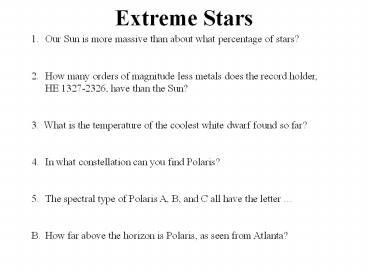Extreme Stars - PowerPoint PPT Presentation
Title:
Extreme Stars
Description:
Examples Pleiades and Hyades in Taurus. Characteristics 1. in Milky Way. 2. loose aggregate ... Characteristics 1. outside of Milky Way. 2. tight ball. 3. few ... – PowerPoint PPT presentation
Number of Views:190
Avg rating:3.0/5.0
Title: Extreme Stars
1
Extreme Stars
- Our Sun is more massive than about what
percentage of stars? - How many orders of magnitude less metals does the
record holder, HE 1327-2326, have than the Sun? - 3. What is the temperature of the coolest white
dwarf found so far? - In what constellation can you find Polaris?
- The spectral type of Polaris A, B, and C all have
the letter - How far above the horizon is Polaris, as seen
from Atlanta?
2
Extreme Stars
- Our Sun is more massive than about what
percentage of stars? - 90
- How many orders of magnitude less metals does the
record holder, HE 1327-2326, have than the Sun? - 1/250,000 5 orders of magnitude
- 3. What is the temperature of the coolest white
dwarf found so far? - 4300 K, cooling for 8-9 Gyr
- In what constellation can you find Polaris?
- Ursa Minor
- The spectral type of Polaris A, B, and C all have
the letter - F
- B. How far above the horizon is Polaris, as seen
from Atlanta? - 33.5 1 degrees
3
Neutron Stars
Progenitor single one massive (gt 8 Msun) star
with Fe core double one star white dwarf
mass slurping Process 1. p and e
crushed together into n and neutrinos 2.
BOUNCE SN EXPLOSION 3. shock wave blows
star apart 4. neutron degeneracy pressure
stabilizes core
4
Neutron Stars
5
Neutron Stars
Progenitor single one massive (gt 8 Msun) star
with Fe core double one star white dwarf
mass slurping Process 1. p and e
crushed together into n and neutrinos 2.
BOUNCE SN EXPLOSION 3. shock wave blows
star apart 4. neutron degeneracy pressure
stabilizes core Observe radio pulses
pulsar for millions of years regularity
ROTATION narrowness SMALL
OBJECT Notes not really a star 1.4 Msun
20 km in diameter intense magnetic fields
not all neutron stars are pulsars
6
Neutron Stars
7
Millisecond Pulsar
8
Black Holes
Progenitor single one massive (gt 20 Msun) star
with Fe core double one star neutron star
mass slurping Process 1. core more than
3 Msun 2. neutrons cant hold against
gravity! 3. matter crushed into no
size 4. gravity so intense, not even light
can escape Observe nothing (directly) in
binary systems X-ray source
ENERGETIC large star tossed MASSIVE gas
flowing BINARY no object seen
DARK variability TINY
9
Cygnus X-1
10
Black Holes
Notes black holes ARE NOT vacuum
cleaners black holes ARE heaters and
eaters Special nothing goes faster than
light Relativity
11
Special Relativity
12
Black Holes
Notes black holes ARE NOT vacuum
cleaners black holes ARE heaters and
eaters Special nothing goes faster than
light Relativity General light is affected by
gravity Relativity
13
General Relativity
General Relativity
14
Light Affected by Gravity?!
15
Black Holes
General light is affected by gravity Relativity
photons use energy to dig their way out of
black hole ? redshift as we see them ?
photon frequency as clock ticks time dilation
16
Schwarzchild Radius
imagine a photon at the event horizon --- same
as the Schwarzchild radius PE KE GMBHmph/R
(1/2)mphv2 of course, v c R
2GMBH/c2 (this is the classical derivation, but
the relativistic derivation yields the same
result) Sun 3 km Earth 9 mm
17
Black Holes
18
Cluster Evolution
banana peel
19
Open Clusters
- Examples Pleiades and Hyades in Taurus
- Characteristics 1. in Milky Way
- 2. loose aggregate
- 3. few hundred stars
- 4. young less than 500 million yrs
- 5. massive stars still present
- 6. gas and dust
- 7. heavy metals
20
Hyades
21
Globular Cluster M80
22
Globular Clusters
- Examples M13 in Hercules, Omega Centauri
- Characteristics 1. outside of Milky Way
- 2. tight ball
- 3. few hundred THOUSAND stars
- 4. old more than 10 billion yrs
- 5. G, K, M stars, red giants, white dwarfs
present - 6. no gas and dust
- 7. few metals
23
Globular Cluster Mult Main Seq
Bedin et al. 2004 ? Centauri with
HST observe double main sequence multiple
turnoffs multiple subgiant branches deduce dif
ferent He content? two star formation
epochs? star cluster/tidal tail behind?
24
..
25
Densities of the Stars
Calculate the densities in grams/cubic centimeter
(g/cm3) of A. our Sun today 1.0 Msun
1.0 Rsun B. Sirius 2.0 Msun 2.0
Rsun C. Proxima Centauri 0.1 Msun 0.1
Rsun D. Betelgeuse (red supergiant) 15.0
Msun 650.0 Rsun E. future Sun (white dwarf)
0.5 Msun 0.01 Rsun




























![❤[PDF]⚡ 1000+ Sudoku Diabolical to Extreme Puzzle Book for Adults: A Book With 1000+ PowerPoint PPT Presentation](https://s3.amazonaws.com/images.powershow.com/10085718.th0.jpg?_=20240725054)
![[PDF] DOWNLOAD 1000+ Sudoku Diabolical to Extreme Puzzle Book for Adul PowerPoint PPT Presentation](https://s3.amazonaws.com/images.powershow.com/10096033.th0.jpg?_=20240811083)
![[PDF] READ Free Extreme Word Search: With 300 Puzzles (Brain Busters) PowerPoint PPT Presentation](https://s3.amazonaws.com/images.powershow.com/10102914.th0.jpg?_=202408200910)
![Read [PDF] Extreme Dot to Dot Puzzles for Adults: Immerse Yourself in PowerPoint PPT Presentation](https://s3.amazonaws.com/images.powershow.com/10103798.th0.jpg?_=20240821016)